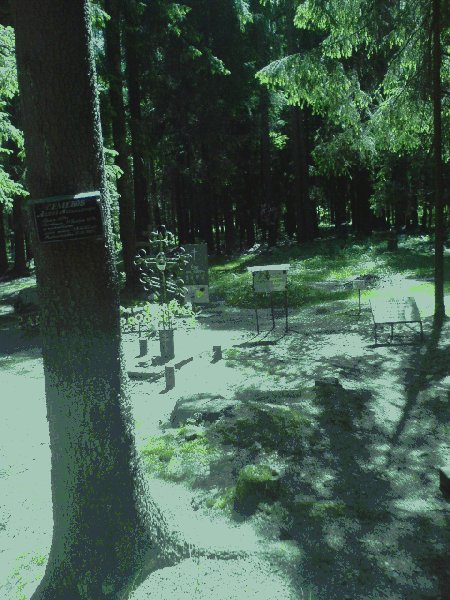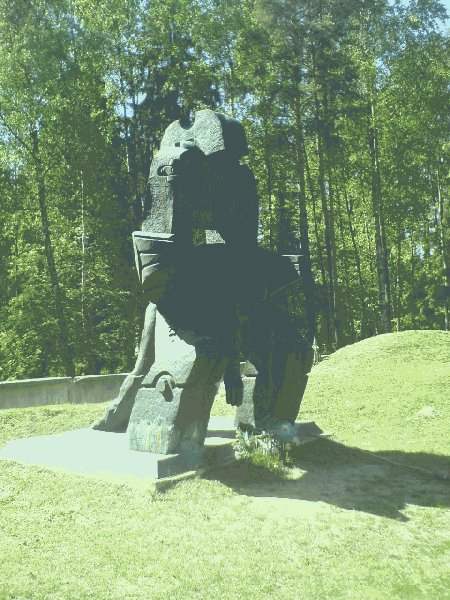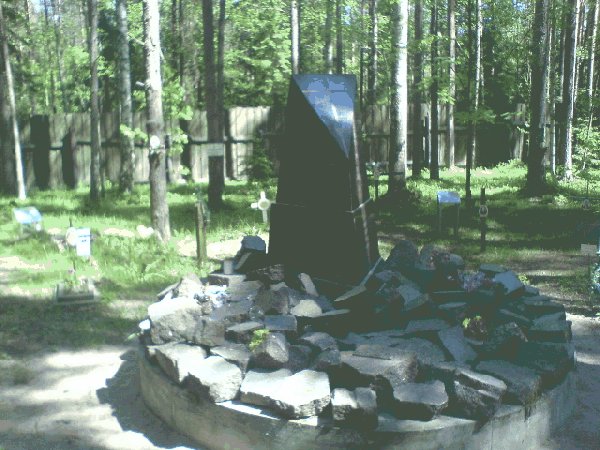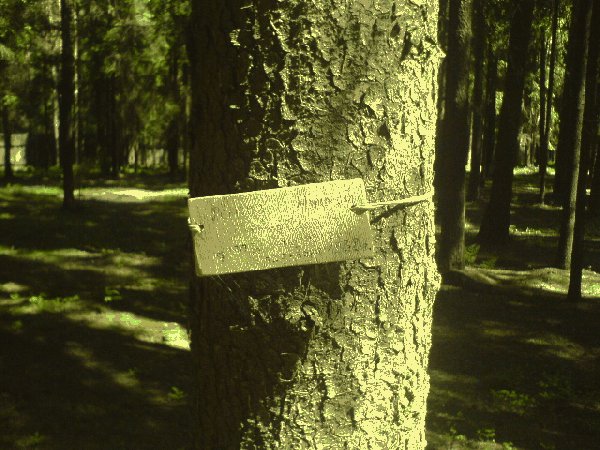The Levashovo cemetery and the Great Terror in the Leningrad region
A- Context
This part of this case study has much in common with the Butovo study,, as the overall context of the Yezhovshchina is the same.
The Yezhovshchina or Stalin’s Great Terror, as it was called by American historian Robert Conquest (Conquest, 1968), took place mainly between 1937 and 1938 and, for the most part, was organized on the basis of the operational orders of the NKVD (the People's Commission for Internal Affairs), then headed by Commissar for Internal Affairs, Nikolai Ivanovich Yezhov (for biographical references see Jansen Petrov, 2002 or Getty Naumov, 2008).
Political repression against Stalin’s former and potential political opponents had already begun following the aftermath of the murder of Leningrad party organization boss and Politburo member, S. M. Kirov on December 1, 1934 (proceeded by the first trial against Kamenev and Zinoviev in 1935 and the Moscow show trials, 1936-1938). However, the Great Terror was far more than a mere act of large-scale political repression, and therefore had a more direct goal than subjugation: it was a moment of social engineering during which the Stalinist group intended to definitively reshape Soviet society and put an end to the social disorder that the transformational Stalinist project had caused previously. Consequently, after a relative relaxation of societal repression in the past few years, the Stalinist regime went ahead with a large-scale attack on its perceived enemies.

General view of the cemetery with personal objects of the victims’ parents
Photos : © François-Xavier Nerard :
These operations, which were to last from the very end of July 1937 until the first days of November 1938, were carefully organized during the whole month of July by the highest Soviet authorities (Stalin, Yezhov and his staff). The main violence was organized by a dozen operational orders (prikazy) given by Yezhov. First was order 00447 that was directed against all the well-known enemies of the regime, who had often been repressed in the past: the kulaks and other former “opponents” (Socialist-Revolutionaries (SR), White army officers, priests…). It was completed by a series of prikazy on “national operations” that targeted the border minorities from the Soviet Union (Martin, 1998). These are orders 00439 (on Germans), 00485 (on Poles), 00486 (on wives of “enemies of the people”), 00593 (on Kharbintsy and Japanese spies), 00693 (on immigrants in the USSR), and five others (on Latvians, Finns, Greeks, Romanians and Estonians). It should be noted that bringing these operations together is not a post-factum scientific reconstruction by historians, but was evident in the official documents of the NKVD (Werth, 2006). At the heart of this operation was the aim, explicitly noted in order 00447, to put an end “once and for all” to the presence of enemies in Soviet society. The operation therefore had to be a maximal one and wipe out all remnants of the former social order that had been persecuted hitherto.
The methods were very characteristic of the Stalinist Terror and reminiscent of the way the dekulakization of the countryside had been organized. Quotas of people to be arrested had been drawn up in July. The victims were to be organized into two categories, the first included the “most active and hostile elements”. These people were to be judged by a troika (an extra-judiciary organ composed of the regional head of the NKVD, the regional secretary of the party and the regional prosecutor) and if condemned (but in the text of the order, there is almost no possibility that they would not be condemned) were to be shot immediately. The second category concerned the “less active but nevertheless hostile elements,”. Those included were to be arrested and sent to a camp for “eight to ten years”. Prison was envisaged only for the “toughest”.
The whole month of July can be characterized by what Nicolas Werth has called “a dynamics of the quotas” (Werth, 2006: 20). A meeting of the Politburo (Political Bureau, the supreme organ of the Communist Party) at this time noted that “former kulaks and criminals who returned back home after their punishment were the main instigators of anti-Soviet crimes”, it was decided to send a telegram to regional authorities asking them for a census of these people and an estimate of the number to shoot or to exile. A back-and-forth game began between the center and the regions to establish the quotas. These were written down many times, not only on July 30 in order 00447. It was therefore not uncommon for the regional heads of the NKVD to ask (once, twice or more!) for an augmentation of their quotas. The authorizations were given personally by Yezhov, Stalin or Molotov (Junge, 2003; Werth, 2006)
For the national operations the system was a little different as there were no quotas, although people were still divided into two categories (one to be shot, the other to be sent into camps). At the end of the “instruction”, a short summary of each case was written down. Every ten days the summaries were transmitted to a commission of two men (called the dvoika): the regional head of the NKVD and chief prosecutor) for verdicts. These were, in turn, validated in Moscow by Yezhov and Vyshinsky.
The official end of operations was November 17, 1938. The Central Committee of the Party and the government (Sovnarkom) of the USSR issued a text condemning the “defects and perversions” of the action of the NKVD during the years 1937-1938 and therefore forbade “all sorts of mass operations” and dismantled the troiki and dvoiki. Yezhov, the master of these operations (he entered Stalin’s Kremlin office 278 times during these two years, spending a total of 833 hours and 45 minutes there) was crushed by the end of 1938. He had been forced to accept a nomination as People’s Commissar for Water Transportation in April 1938 and resigned from his job in the NKVD on November 23, 1938. He was arrested on April 10, 1939 and shot on February 6, 1940. In the wake of his fall and of the nomination of L. P. Beria as People’s Commissar for Internal Affairs, most of the cadres of the NKVD were also purged.
The precise end result of these operations is difficult to establish, but the total of the condemnations is estimated at roughly 1,300,000 of which 700,000 were sentenced to death, most of the others were sentenced to ten years in the camps (document translated in Werth, 2006: 143). The national operations were far more violent as three quarters of those arrested were sentenced to death. For order 00447, the proportion of those executed was “only” one in two.
B- Decision-makers, Organizers and Actors
It has long been discussed whether the murder of Leningrad party boss, S. M. Kirov, on December 1, 1934 marked the beginning of the Terror in the USSR. In the Leningrad region at least, it is undeniable. First of all, the arrival of the main organizers of the Terror on December 10, 1934 and the designation of a new head of the regional NKVD, namely Leonid Mikhaylovich Zakovsky suggest as much. It was under Zakovsky's rule that most of the repressions took place and were shaped. A few days later, on December 15, Andrei Aleksandrovich Zhdanov became the regional head of the party.
Several waves of repression hit the Northern capital between 1934 and 1937, even before the mass operations began. 40,000 people were deported from the city during what was called the “Kirov stream”. Just for the operations of February-March 1935 (initiated by the circular of February 27, 1935), more than 11,000 “former” citizens were expelled from the city (on the consequences see Chuykina, 2006: 83-84).

Sculpture "the moloch of Totalitarism"
Photos : © François-Xavier Nerard :
As for the Great terror itself, Zakovsky obtained one of the highest quotas for the implementation of operational order 00447: 14,000 people (of whom 4,000 were to be shot), he also presided over the troika. The representatives of the party in the troika varied between the First Secretary Zhdanov, but also the Second Secretary P. Smorodin (until august 1937), and later T. Shtykov (from September 1938). The regional prosecutor, also a member of the troika, for the whole period was Boris Pozern. These operations were well organized in the Leningrad region as recently published documents testify (Razumov, 2002: 618-638). Zakovsky composed a text explaining the central instructions to his subordinates in a specific operational order on August 1, 1937. The Leningrad region was divided into 12 operational sectors in accordance with the specific border areas of Pksov, Murmansk and Kingisepp.
For all theses subdivisions a person responsible for the operations was nominated and additional staff assigned. For example, 212 persons for the Leningrad city zone (mostly students from military and police institutes but also members of the NKVD in the reserve). The lists of arrests were to be established on information provided by the different security organs and validated personally by Zakovsky. The operation was to be reported daily to the regional head of the NKVD.
All the stages of the process were carefully thought through: the arrested were concentrated into one place for each above-mentioned subdivision, either in prisons or in “centers for pre-trial detention” (DPZ). In the city of Leningrad, these places were the famous “Kresty Prison” on the Arsenal embankment and the DPZ of the Militia. It seems that the executions in the region were organized at different points, but mainly took place in the prisons (Razumov, 2006: 5 or Razumov, 2002: 626). During the summer of 1937, the NKVD organs looked for the best place to bury the corpses. The main secret cemetery was found north of Leningrad in the forest of Pargolovo, near the village of Levashovo. It is the only place the existence of which is confirmed by written sources, but there are probably other places such as the Preobrazhensky cemetery. A woman selling flowers there was arrested in November 1937 and accused of “anti-soviet propaganda” as she was telling people in the cemetery of the “secret burials” of victims of the Terror (Razumov, 2002: 604-617). This case will be analyzed more extensively in section D below.
The Yezhovshina in the Leningrad region also targeted people already in prisons and other places of detention, as mentioned in Zakovsky's operational order 00123 (August 9, 1937). ?n August 16, 1937, Yezhov once again ordered Zakovsky to clean up the prison camps of already arrested but nevertheless “active anti-soviet elements” (Junge, 2003: 100-102), specifically targeting the prison camps of the Solovky Islands in the White Sea (the first of the Gulag camps). Yezhov gave them a quota of 1,200 for the first category. The orders were implemented: the Sandarmokh tract is the location where the first 1,111 prisoners were shot (Shapoval, 2002; Junge, 2003: 52). The implementation of the order given by Zakovsky on October 16, 1937 was supervised by M. Matveev. Seven hundred more prisoners were later executed.
Zakovsky was called by Yezhov in Moscow and promptly became his aide. He was later replaced by Mikhail Litvin, the former head of the secret-political section of the NKVD, another close protégé of Yezhov, on January 20, 1938. Litvin remained in this post until November 1938, almost until the very end of the Terror, he committed suicide and was replaced by S. Goglidze, a close collaborator of Beria’s, who prolonged and intensified the Terror. On January 31, 1938, after a meeting of the regional heads of the NKVD in Moscow, the Politburo authorized an increase in the quotas of people to be shot on the basis of the order 00447. For Leningrad, this augmentation was of 3,000 (i.e. 75%). On April 13, 1938, this figure was once more increased by 1,500 in a special Politburo resolution (Junge, 2003: 129), bringing the overall figure to 8,500.
C- Victims
It is still difficult to give a precise overall figure of the victims of the Great Terror in the Leningrad region as different repressive structures were galvanized. Globally 65,223 (of which 31,339 came under order 00447) were arrested from October 1, 1936 to July 1, 1938 (Werth, 2006: 143). Another source puts the total at 73,045 arrests in the Leningrad region (Mozokhin, 2006: 333-341).

Finish victims memorial
Photos : © François-Xavier Nerard :
Nevertheless, the publication of the first eight tomes of the Leningrad Martyrology by Anatoly Razumov gives us a more precise idea of the victims of the Great Terror (Razumov, 1995-2008). This data was partly analyzed by Melanie Ilic (Ilic, 2000) and Denis Kozlov (Kozlov, 2002), but deserves further statistical analysis as the publication continues. Nevertheless, their conclusions are largely confirmed by the latest publication of statistical data undertaken by the team of Anatoly Razumov that concern the year of 1937 and 19,724 people (data from the six first tomes are available from the website: http://visz.nlr.ru/search/stat.html ). Most of the analysis provided in this section are based on these data.
The Great Terror was a marked gendered- phenomenon as 95.2% of the victims were males even if wives and families of the “enemies of the people” were specifically targeted by operational order 00486 of August 15, 1937. Most of them were in their prime (65.8% were younger than 50 years old, 86.4% younger than 60 and the oldest being 85). The gender aspects and consequences of the Great Terror still require thorough scholarly attention and analysis.
The importance of the national operations in regions on the borders of the USSR and of their lethal effects can be read in the statistics on nationalities. The Leningrad region was one of the bloodiest in the USSR: 87% of people arrested were shot, whereas in the Kuybyshev region, the equivalent percentage was 48.16% (Petrov Roginski, 1997). The Great Terror marked the climax of the campaign of repression against nationalities and “enemy nations” that began in 1934-35 (Martin, 1998: 852) and corresponded to a U-turn in Soviet politics regarding nationalities. In the Leningrad region, the process began in March 1935 with deportation to Central Asia and Siberia of Finns (30% of the Finnish population were transferred in 1935-1936), Estonians and Latvians (Martin, 1998: 849).
The Leningrad region was very multinational, and so it is not surprising to see that 65 different nationalities were affected by the orders. Russians moreover represented only 58.5 % of the total population (whereas by 1939, according to the census of that year, they represented almost 90% of the population). The statistics of the victims of the Terror in the Leningrad region, as they were compiled by the team of A. Razumov (see reference above) allow us to have a more precise understanding of the repression . Almost 14 % of the victims were Polish (who represented less than 1% of the population in the 1939 census). The Polish operation there was very important as a report by Yezhov to Stalin describing the operation and the “spy webs” already dismantled testifies (Werth, 2006: 122-125). Leningrad was the third largest region of USSR for the number of arrests after Ukraine and Byelorussia (but Ukraine was far more densely populated). Estonians, Finns (around 4% each) are the two other overwhelmingly over-represented nationalities among the victims. These conclusions are confirmed by the fact that slightly more than 50% of the victims in the Leningrad region were born in the city of Leningrad or its surroundings. 18% were born outside the borders of the USSR. What Martin calls “Soviet Xenophobia”, i.e. “Soviet fear of foreign influence and foreign contamination” (Martin, 1998: 829), can also be read in the fact that rail workers and transport workers (who had links with foreign countries) were also specified as targets, they represent almost 10 % of the total victims.
Figures compiled by A. Razumov also show how the Great Terror can be interpreted as an enterprise of social engineering (Werth, 2006: 32). Communists were certainly victims of the Terror as they represent 13% of the total, despite party membership in 1939 for the whole of the USSR being less than 1.5% (Ilic, 2000: 1520). However, the bulk of the repression (84%) targeted non-party people. Several “enemy” groups, mentioned in the decree 00447 are overrepresented: this is the case for religious practitioners (and especially for women), 5,5%, but also for edinolichniki (the independent peasants who did not join the collective farms), accounting for 7.1%. Peasants as a whole represent 23% of the total. The margins of the Soviet society were thus hit hard by the Terror as confirmed by the high figure of 4.6% for people “without any specific occupation”. This category is especially female (8% of women) as is the category for other non-working persons (on retirement, housewives and dependents), half of these victims are women.
D- Witnesses
The main characteristic of the Great Terror was its absolute secrecy, there were almost no witnesses of the mass killings which took place. This is especially true for the location of burial sites. The already-mentioned case of the artificial flower seller Aleksandra Petrovna reminds us how secrecy was enforced and maintained (Razumov, 2002: 607-617). She was shot because she was accused of telling people about nightly burials in one of Leningrad's cemeteries. Working at the entrance of the cemetery, she became aware of these burials from conversations with people in charge of digging the graves and told the investigators that these corpses were not regular criminals as they were brought into the cemetery at around 7-8 P.M. and buried at night. The NKVD also accused and shot the priest of the cemetery for spreading these “rumors”.
?he Levashovo cemetery where most of the corpses were buried is surrounded by a high wooden fence and is far away from any important habitation or settlement. Moreover, the secrecy was duly maintained throughout the Soviet period. The Levashovo mass graves were looked after by the Leningrad Department of State Security, even after it was officially closed by the KGB in 1965. The fences and entrance gate were even renovated in 1975-76 (Razumov, 2006: 7).
Most of the perpetrators of the Terror were in turn repressed after the dismissal of Yezhov in November 1938 and the nomination of Beria as the People’s Commissar for Internal Affairs. During their interrogation they recalled details about the way in which the Terror had been organized. It remains the main source of evidence about it, even if these testimonies should be used with caution.
E- Memories
The rediscovery of the Stalinist massacres in the Soviet Union is closely linked with the explosion of interest in the history of Soviet society during Mikhail Gorbachev’s perestroika during the second half of the 1980s. In Leningrad, where the mayor, Anatoly Sobchak, was one of the major figures of the reforms, the Levashovo mass graves were rediscovered through the efforts of local activists lead by Valentin Muravsky. The refusal of the KGB to reveal mass burial sites was overruled by a decision of the municipal soviet government of Leningrad on July 18, 1989 (Razumov, 2006: 9). The place of Levashovo was recognized as a “memorial cemetery” (the designation was highly significant as it was the same as the Piskarevka memorial cemetery opened in the 1960s where the victims of the Leningrad siege were buried).

A handwritten and home-made plate reminding a victim’s remembrance
Photos : © François-Xavier Nerard :
Levashovo rapidly and spontaneously became the place of popular memorialization of the Great Terror. It seems that there were other mass burial sites in the region, for example at Toskovo, some forensic investigations took place, but no other place received the same status as Levashovo (Adler, 2005: 1108). Relatives of the victims (even if it was not certain that their parents were actually buried in Levashovo) came there to remember their loved ones. People attached small ribbons to the trees, brought some photographs of their parents or some little plaques with their names and dates. These little signs of mourning mushroomed everywhere in the glade, giving Levashovo a very specific popular atmosphere. This popular appropriation of the mass graves established Levashovo as the center of the memory of the Great Terror in the Leningrad region. As is often the case in Russian regions, this memory is constituted as a web of real places such as Levashovo or the buildings of the NKVD (the “Bolshoi Dom” or the “Big House”) and books of memory (already mentioned above) published both in print and online, and testimonies published by relatives of the victims. When the territory of Levashovo was officially handed over to the municipality by the security services (May 1990), the relevant department began to develop planning projects for the site. These plans were not carried out due to the deepening economic and political crises in Russia at the time.
Afraid of the prospect of soviet-type monumental memorialization, and in an effort to maintain the “popular aspect” of the place, activists led by Anatoly Razumov began to erect some monuments to national minorities hoping that these would have been politically more difficult to remove than small popular signs of grief (interview with the author, June 2008). A monument to Byelorussians and Lithuanians was thus erected on May 8, 1992. It was to be followed by 15 monuments to national minorities or specific groups (Nérard, 2008: 152). The last one was dedicated to the Italian victims of the Terror and inaugurated by the Italian Ambassador to the Russian Federation in July 2007. There are also monuments to Ukrainians, Finns, Ingrians, Germans and to nuns of a monastery and workers from the Leningrad Energy Company. The only non-community monument was built by the municipality of Leningrad in 1996. It is a sculpture of N. Galickaya and V. Gambarov and is called the “Moloch of Totalitarianism”, but it is erected outside the cemetery, just in front of the entrance gate. One of Levashovo's definitive characteristics is the co-existence of private memories (at the entrance, a bell may be rung by visitors to remember their loved-ones) and community memories.
The centrality of Levashovo in the memory of the Terror is recognized by the municipality of Leningrad (later Saint Petersburg). It supported and is still supporting the cemetery by paying the small staff and by offering relatives a chartered bus from the center of the city to the cemetery twice a year (beginning of June and October 30, the day for remembering the victims of political repression). The symbolic status of Levashovo was further reinforced when Lydia Chukovskaya, a well-known writer and dissident, received her State prize in 1995 and gave the money she received to the cemetery, allowing important works on the site.
The almost intimate and personal approach to the Terror is also chosen and developed by Anatoly Razumov and his small team when publishing the Leningrad Martyrolog. The list of people that can be found in such books almost everywhere else in Russia is accompanied by several personal stories on the people whose names were published in the Martyrolog. In most cases it is testimonies from relatives, but it also consists of data from the KGB archives. This individual approach to the Terror is completed by personal photographs of the victims (Razumov, 2006: 638-639, photos 1-88) and not by using photographs from the criminal files, as is often the case elsewhere.
F- General and Legal Interpretations of the Facts

The cemetery fence
Photos : © François-Xavier Nerard :
As in the case of Butovo, near Moscow, the rediscovery of mass murder sites and their memorialization contributes to the interpretation of the Great Terror among historians as well as in Russian society. The very meticulous work of establishing the names and the fate of the victims of the Great Terror is an essential part of this historical work. As a result, it is now easier to name the perpetrators of the Terror. New statistical data now available allows us to better understand who the targets of the Great Terror were. It has allowed us to move beyond the divisions that for a long time marked the historiography (totalitarian school on one side, revisionists on the other) of the centralization of the process and the role of Stalin. The global interpretation of the Great Terror is now much less debated than it used to be and more often expressed in terms of social engineering and of complex interactions of different strata of repression, e.g. as against the elite or against the population (Werth, 2006). The work with previously out-of-reach archives give us some keys to better unlock the mechanisms of the Terror, even if part of this work is still in progress.
Levashovo is the place of the private memories, either of individuals or of groups (ethnic and even professional). The mix of individual and group memory that is to be found in the Leningrad region and in Levashovo leads us to question the meaning of the Terror. As in Butovo, the official support is real (both the municipalities help the setting up of these places of memory), but remains always in the background. Even if at the entrance of Levashovo cemetery there is a small museum, it does not seek to provide a global interpretation in terms of national (soviet) history. It thus leaves open the question of the appropriation of such places by the whole society. Who is coming to Levashovo? Who reads the books of memory? What will happen with such places when the generations directly related to the victims pass away? How will the memory of the Great Terror be transmitted to new generations? All these questions still stand in sharp focus for Russian society.
G- Bibliography
Articles
ADLER, Nancy, 2005, “The Future of the Soviet Past Remains Unpredictable”, Europe-Asia Studies, 57: 1094-1119.
FERRETTI, Maria, 1996, “La mémoire refoulée. La Russie devant le passé stalinien”, Annales HSS, 50: 1237-1257
ILIC, Melanie, 2000, “The Great Terror in Leningrad: A Quantitative Analysis”, Europe-Asia Studies, 52: 1515-1534.
KOZLOV, Denis, 2002, “The Leningrad Martyrology: A statistical note on the 1937 executions in Leningrad city and region”, Canadian Slavonic Papers, 44: 175-208.
MARTIN, Terry, 1998, “The Origins of Soviet Ethnic Cleansing”, The Journal of Modern History, 70: 813-861.
SHAPOVAL Iurij, 2002, “Soloveckaja Tragedija : nezamecennaja godovscina” [“The Tragedy of the Solovki: an unnoticed anniversary”], Zerkalo Nedeli, 16. Available online https://zn.ua/3000/3150/34604/
WERTH, Nicolas, 2006, “Les 'opérations de masse' de la 'Grande Terreur' en URSS, 1937-1938”, Bulletin de l'IHTP, 86: 6-167.
Books
CONQUEST, Robert, 1968, The Great Terror; Stalin's purge of the thirties, New York: Macmillan.
CUJKINA, Sof'ja, 2006, Dvorjanskaja Pamjat: 'byvšie' v sovetskom gorode (Leningrad, 1920-30-e gody), ["The Memory of Nobles: the 'former' people in a soviet city (Leningrad, 1920s-1930s)"], Saint Petersburg: Evropejskij University.
DRACH, Ivan, KULAKOVSKI, Petro, SMIRNOV, G. L., SHAPOVAL, Ju. I ZINCHENKO, A. L., 1997, Ostannja adresa: do 60-richchja solovetskoï trahediï [Last address: for the 60th anniversary of the Tragedy of the Solovki], Kiev: Vyd-vo Sfera.
GETTY, John Arch, 1985, Origins of the Great Purges: the Soviet Communist Party reconsidered, 1933-1938, Cambridge; New York: Cambridge University Press.
JUNGE, Marc, BINNER, Rolf STEPANOV, A., 2003, Kak terror stal "bol'shim": sekretnyj prikaz no. 00447 i tekhnologija ego ispolnenenija, [“How the terror became 'great': secret order n° 00447 and the technology of its implementation”], Moscow: AIRO-XX.
MARTIN, Terry, 2001, The affirmative action empire: nations and nationalism in the Soviet Union, 1923-1939, Ithaca: Cornell University Press.
MOZOKHIN, Oleg, 2006, Pravo na repressii: vnesudebnye polnomochija organov gosudarstvennoj bezopasnosti, 1918-1953 [«The law for repression : extrajudiciary powers of the organs of the State security, 1918-1953»], Moskva; Zhukovskij: Kuchkovo pole.
RAZUMOV, Anatoli Ja., 1997-2008, Leningradkij Martirolog, 1937-1938 [The Leningrad martyrology, 1937-1938], 8 tomes, Saint-Petersburg: Rossijskaja Nacional’naja Biblioteka.
RAZUMOV, Anatoli Ja., 2006, Levashovskoe memorial’noe kladbishe [The Levashovo Memorial Cemetery], Saint-Petersburgh: Rossijskaja Nacional’naja Biblioteka.
WERTH, Nicolas, 2007, La terreur et le désarroi: Staline et son système, : Perrin.
Book Chapters
NERARD, François-Xavier, “La mémoire de Boutovo, massacres de masse des années trente en Russie soviétique”, in BUCHET Luc and SEGUY Isabelle (eds.), 2008, Vers une anthropologie des catastrophes: Actes des 9e journées d’anthropologie de Valbonne, Antibes: Éditions apdca, pp.143-159.
PETROV Nikita, ROGINSKIJ Arsenij, “Pol’skaja operacija” NKVD 1937-1938 gg” [“The Polish operation of the NKVD in 1937-1938”] in GUR’IANOV, A. (ed.), 1997, Repressii protiv Poljakov i pol’skih graždan [“Repression against Poles and Polish Citizens”], Moscow: Zvenia, pp. 22-43.
Translated into English
PETROV Nikita, ROGINSKY Arseny, “'The Polish Operation' of the NKVD, 1937-1938” in McLOUGHLIN, Barry McDERMOTT, Kevin (eds.), 2003, Stalin’s Terror: High Politics and Mass Repression in the Soviet Union, London: Macmillan, pp.153-172.
Websites
Website of memory of the victims of the Stalinist terror in the North-Western region of USSR, maintained by A. Razumov, http://visz.nlr.ru/index.html
Website of the Memorial Society, http://old.memo.ru/memory/martirol/index.htm]
Website of the Saint-Petersburg center for scientific information, Memorial, http://www.memorial-nic.org/









